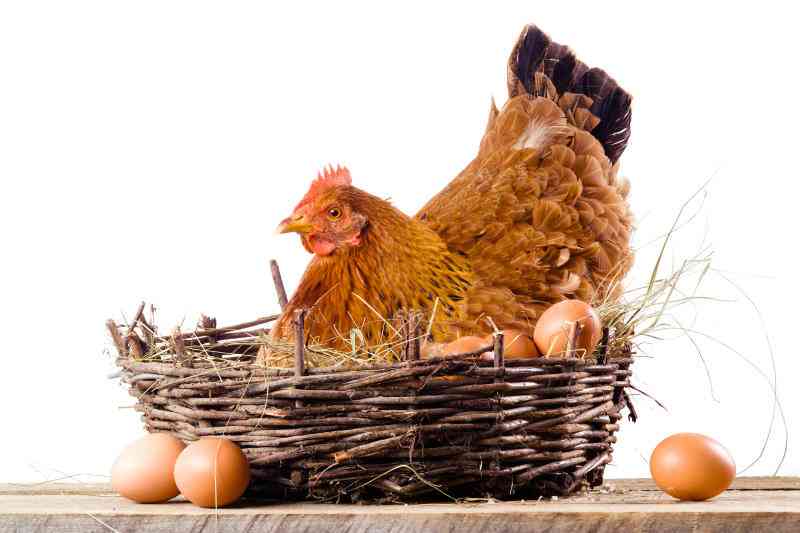
Chicken in a nest with eggs [iStockphoto]
Producing clean table eggs from a flock raised in a deep litter system has always been a big challenge to most poultry farmers. It even becomes a tall order during the rainy season when the litter quality deteriorates, and you experience wet litter all over the place and more so around the drinkers. Dirty eggs can carry harmful bacteria and if these bacteria enter the yolk through micropores on the shell surface and if not properly cooked, they can potentially cause food poisoning. So, as farmers go about their farming business, here are 10 things you can do to encourage hens to lay their eggs in clean nest boxes. There will be no need to discard dirty eggs again with these little steps.
Introduce perches or platforms during the growing periodA perch is a horizontal wooden or metallic bar raised from the ground and placed on the floor of a resting area in the chicken house for birds to roost on. They are introduced when the birds are three to six weeks of age. Birds will be stimulated into jumping and nesting behaviour at an early age with ease. This behaviour will become handy during egg laying. Provide a space of 3cm per bird on the bar rod.
Increase light intensityDo not excessively darken the chicken house, instead provide a light intensity not less than 20 lux (2 candlelight). When the house is extremely dark, the birds avoid perching during the growing period. When birds are in production, dark corners provide ideal sites to lay floor eggs.
Introduce laying boxes earlyIntroduce laying boxes or nests early before the birds reach point of lay. My suggestion would be to bring them in at 12 weeks of age if they are mobile. An ideal situation is to have permanent boxes in the units. This will allow them to perch on the nest boxes and get used to the idea before they come into lay. In addition, keep the entrance of nests closed until a week before expected drop in eggs. Birds naturally start to look for nesting sites a week before the first egg comes. Do not open nest boxes too early as the birds will lose interest in them.
Walk the birdsMake sure the poultry attendant walks inside the units as regularly as possible along the edges waking up the birds and watching over them. This habit should start from placement and continue during production. Ten to 12 rounds inside the units will suffice. This act will discourage hens from floor nesting especially in the morning when most eggs are laid.
Avoid dark or shaded areasThe most common area is normally the corners of the units and under the nest boxes. Pullets will prefer alternative nesting sites which are dark and private, pick such birds and place them in the nest boxes and fence off such corners using wire mesh.
Up frequency of egg gatheringAs egg production slowly peaks, increase the frequency of egg collection to a minimum of six times a day. Uncollected floor eggs will encourage more hens to nest on the floor, a habit that once developed is difficult to erase.
Feeding time vs egg-laying timeFeed your layers early in the morning, say 30 minutes after daybreak (lights on), or delay feeding by six hours after daybreak. Avoid feeding when birds are laying most of the eggs. If this happens some eggs will be laid near the feeders. Most eggs are laid in the morning in our tropical climate.
Provide water continuouslyWater must be provided all the time and especially during the feeding period. If for some reason there is a disruption in water supply, birds tend to lay eggs near drinkers as they wait for water.
Nest boxesEnsure you have enough nest boxes for the number of birds. Keep five hens per one nest hole and do not keep more than that number especially during peak egg production at 32 weeks of age. Keep the nest with clean wood shavings and not more than 55 cm above the ground.
Healthy birdsFinally, always keep your flock healthy and if you see deterioration in egg quality, consult your local vet.
[The writer is the Head vet at Kenchic]
 The Standard Group Plc is a multi-media organization with investments in media
platforms spanning newspaper print
operations, television, radio broadcasting, digital and online services. The
Standard Group is recognized as a
leading multi-media house in Kenya with a key influence in matters of national and
international interest.
The Standard Group Plc is a multi-media organization with investments in media
platforms spanning newspaper print
operations, television, radio broadcasting, digital and online services. The
Standard Group is recognized as a
leading multi-media house in Kenya with a key influence in matters of national and
international interest.



